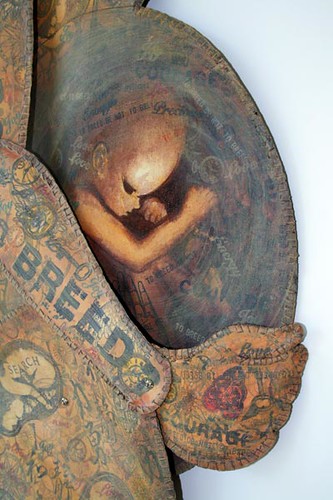In the pre-recession economic good times, as elsewhere in the world, Indonesia's art scene became, over the last decade, the domain of wealthy dilettantes and businessmen collectors. Riches awaited artists who could hype their weird and wacky efforts to levels not seen since nouveau riche former enfant terrible (lots of French today) Damien Hirst first started slicing up farmyard livestock and flogging the pieces for millions of dollars a pop.
The art market in Indonesia has become so commoditized and overlaid with late capital's reductive media hyped numbers game that it can be hard to get a handle on what a given artist is actually trying to say beyond, "Make me rich." Jakarta's deracinated population is generally not very arty and, unlike the rest of the country, seem to share only a culture of common materiality.
The modern visual arts may indeed be in a parlous condition but things weren't much different previously in Indonesia. Suharto's New Order weeded out those involved in the arts deemed subversive and dangerous (such as Pramoedya Ananta Toer) leaving local art as a pretty but ultimately banal and toothless exercise in tourist sponsored heritage culture, shorn of sweat, dirt, vitality and any broader social significance.
Wandering around modern art galleries always gives me the willies however. I mean, I can appreciate the skill needed to compose a nice tune or to be able to dab a bit of paint into a realistic portrayal of a scene, but the conceptual stuff always finds me seriously conflicted and ambivalent. Is it genius or rubbish? Surely I could have done that? Or could I? Or does that even matter?
I remember visiting an exhibition of modern art with a friend back home in London during my teenage years. At one point we came across a piece simply called Blankets by somebody called Barry Flanagan. The 'installation' as I believe these things are called in the parlance, consisted of a pile of blankets... and that was it. A puckish commentary on the nanny state or a load of rubbish? Whatever, we had great fun imagining Mr Flanagan sending a postcard to the Arts Council from the Bahamas. "Dear Arts Council, thank you for the £20,000, wish you were here, love Barry."

Later in the same exhibition we found ourselves musing on what appeared to be another installation piece, a metal abstract shape with wheels on the bottom containing familiar household products. Alas our pretentious critiques were brought back down to earth when one of the cleaners entered stage left and wheeled her trolley, the artwork in question, away to do some polishing elsewhere in the gallery.
Back to Latitudes in Transit though and the rubbish/genius dichotomy. I felt, as I wandered around, as if I had a little devil and angel on each shoulder like in the cartoons, each trying to persuade me of their point of view. My fictional angel was called Agus Sudharmono, Emeritus Professor of Fine Art at Airlangga University in Yogyakarta and the demonic character hovering over my other shoulder was simply called Bambang, a part-time bakso salesman from North Jakarta.

On to the first piece then, My Pink Engagement by Tiarma Sirait. Over to Pak Agus first: "Yes, to me this image of a bride in a pink dress with her back turned to us works on several levels, the bride’s loose and uncut hair is simultaneously a symbol of promiscuity and virginity. The use of textiles in this piece satirizes the hyperbole of the fashion world and the way that it emasculates the female subject."
Right on. And Bambang? Your thoughts? "Lord Allah Almighty! This is like a birthday card but backwards. You have to be an artist to do this stuff? I could have done that in a couple of hours. My eight-year-old son has done better stuff in his school art class."
Okay we'll try another one, To Breed or Not to Breed by Lie Fhung. Agus? "These mannequins dangling from thin wires at first look suicidal. However the lifelike foetus in the mother's womb is essentially an affirmation. Overall, the surreal contrast reflects a woman's feelings of being torn between wanting a baby and also wanting to retain her freedom."

And Bambang? "Jesus H. Akbar! Do they let kids see this? That's not right, I've a good mind to write a very stiff letter to the newspaper, probably on cardboard or something."
And that was just the start. I left the gallery as confused and conflicted as ever. Is it a sign of progress that Indonesian artists are now as witheringly pretentious as those on the international scene or is this a genuine aesthetic movement that will inspire an intellectual revolution in the masses? Is avant-garde, as John Lennon once noted, merely the French word for bullshit? Well, I may not know about art but I know what I like.

